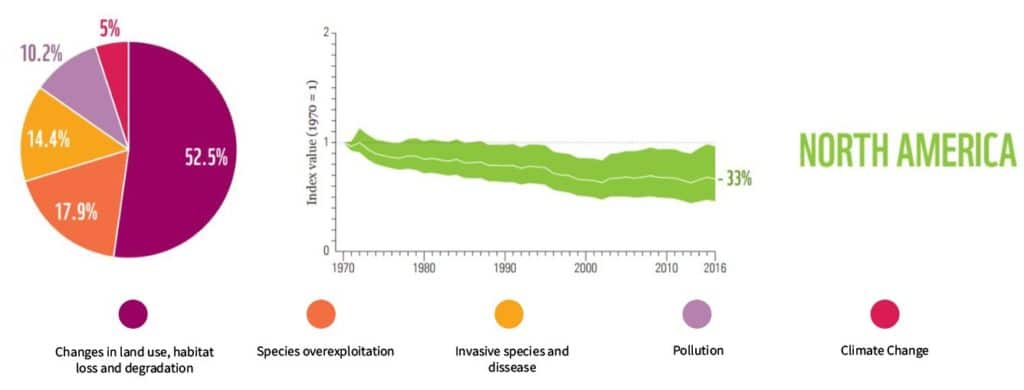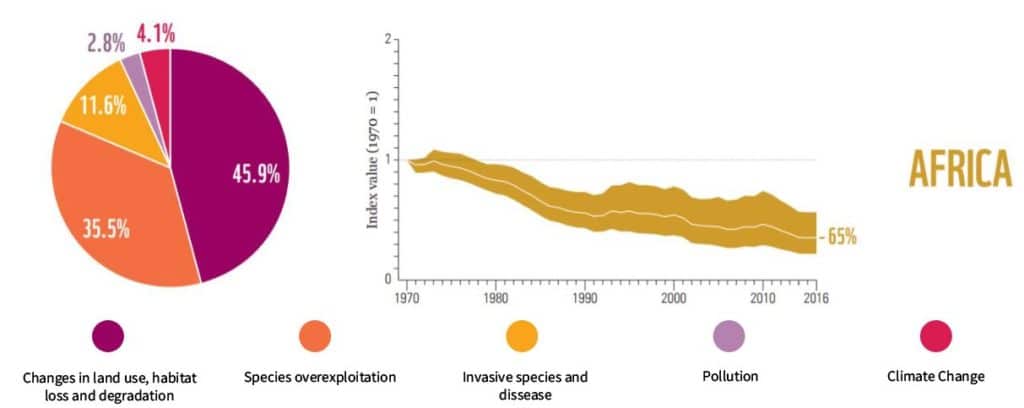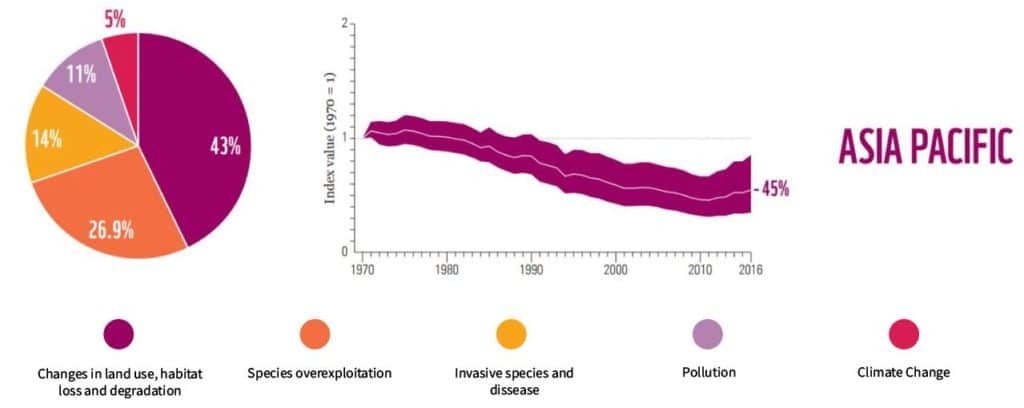What Percentage Of Animal Species Are We In Danger Of Losing
The Statistics of Biodiversity Loss [2020 WWF Report]
The Living Planet Study 2020 (LPR) shows us that global biodiversity loss is at its worst. In guild to requite ameliorate directions for allocating resources, a regional assessment was performed which we will distil for y'all in this article.
—
In the LPR 2020, five major threat categories were used to illustrate the impacts that are driving biodiversity's decline. Through this frame, governments and organisations can better come up with solutions or mitigations that are suitable for the ecosystems as well as the local communities.

Soure: Living Planet Report 2020, WWF.
The analysis was carried out for 5 regions: Europe and Central Asia, Asia Pacific, Latin America & Caribbean, Africa and North America. Taking species population as a measure out, a significant loss in biodiversity was establish in all regions, with encroachment on natural land identified as the near prominent threat to wildlife. Latin America & the Caribbean have sustained a loss of 94% since 1975.
Here, we volition guide you through threats each region is facing and give some current examples.
North America

Source: WWF Living Planet Report 2020.
- Nearly 3 billion birds lost in the past l years
- Possible causes: Habitat loss, chemical pollution (pesticide)
- Water level of the Keen Lakes, biggest freshwater reservoir area in North America, at a historical low
- xxx% of its institute-pollination network has disappeared
Y'all may also like: Extreme Temperatures – Part Iii: Canada | Biodiversity Crisis: North America Lost 2.9 Billion Birds Since 1970
Europe and Cardinal Asia

Source: WWF Living Planet Report 2020.
- Simply 23% of species and 16% of its habitats are in good health
- one,677 out of 15,060 European species are threatened with extinction; almost endangered are snails, clams and fish
- 6 animate being, bird and fish species, including the Saiga antelope, the gyrfalcon and the Farsi leopard, are facing risk of extinction in Russia
You may also like: Europe's Virtually Invasive Species Identified- Study | The UK is Failing to Protect its Biodiversity- Report.
Latin America & Caribbean

Source: WWF Living Planet Study 2020.
- Major negative trends observed in reptiles, amphibians and fish
- A type of chytrid fungus, which originated in Asia, has been causing declines in 500 amphibian species and driven around 90 of them to extinction
- 2019 record breaking dry seasons and forest fires lead to a surge in deforestation, with 30% more than than the previous year
You may besides like: Deforestation in Brazilian Amazon Soars to a 12-Yr Loftier
Africa

Source: WWF Living Planet Report 2020.
- Increasing threats of extinction for the species in the Mara River Basin
- The ecosystem provides livelihood for effectually 1.one meg locals
- 76% of endemic freshwater species in Lake Victoria are threatened with extinction
- Illegal hunting and mining have driven down the Grauer'due south gorilla population in the Congo by 87% .
You may also like: Top Courtroom in Westward Africa Finds Guinea Officials Guilty in Mine Conflict | A Planned Oil Drilling Project Threatens the Okavango Delta Ecosystem
Asia Pacific

Source: Living Planet Report 2020.
- Nearly 3 billion animals were killed or displaced by Australia's devastating bushfire season of 2019 and 2020
- In Bharat, 3% of bird species face extinction; 19% of amphibians are threatened or critically endangered; over 12% of wild mammal species are threatened with extinction
- More 80% of East and Southeast Asia's wetlands are classified as threatened due to homo activity.
We are in a fourth dimension of global upheaval, both politically, economically and in regards to our surroundings. The latter has non yet superseded the two former, only report similar the LPR are driving a growing agreement on the gravity of the situation. Our life-support system, the world nosotros live in, is in a critical land and to simply understand and acknowledge this is the first footstep.
You may also similar: Commonwealth of australia Releases Study on 2020 Bushfires an biodiversity loss, Admitting That Climate Change Was the Driving Factor | WWF Releases 'Emergency Action Plan' To Save Chinese White Dolphins
This article was written by Fly Ki Leung. Photograph by Warlen G Vasco on Unsplash.
You might also like: Impacts of Fast Way on the Environment
Source: https://earth.org/data_visualization/biodiversity-loss-in-numbers-the-2020-wwf-report/
Posted by: nguyencreformen.blogspot.com

0 Response to "What Percentage Of Animal Species Are We In Danger Of Losing"
Post a Comment